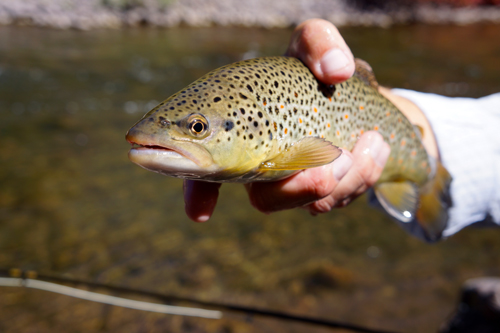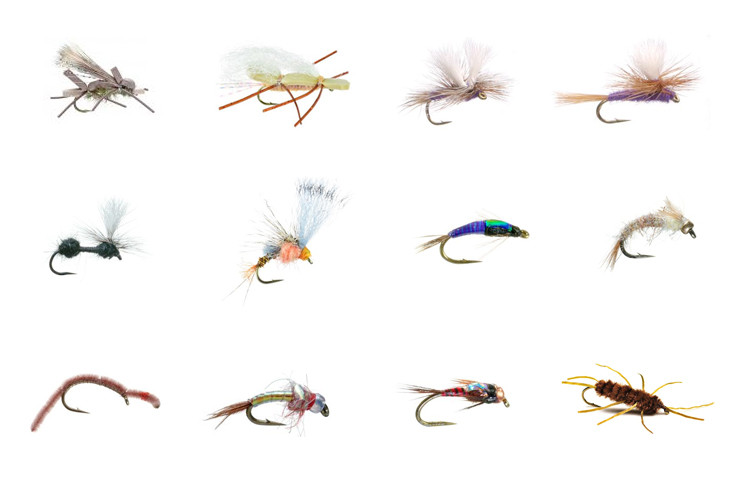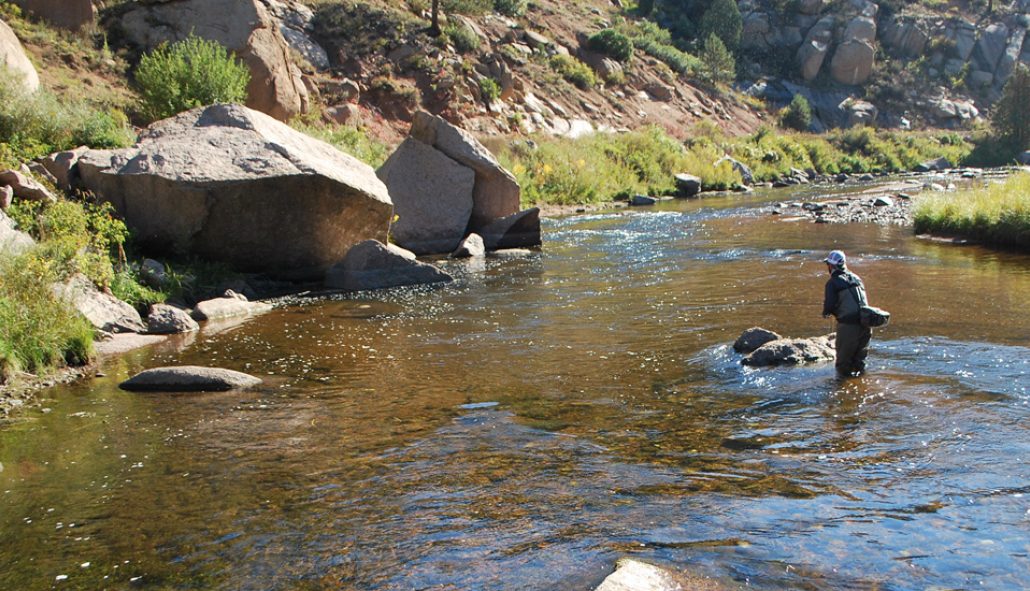And on the off chance you haven’t heard me say this, then a quick scroll through a recent guide trip report or two should get you up to speed in a hurry. Rarely has a day been ‘easy’, but if you put the right plan together for approaching the river, the fishing around here has been the most consistent and productive we’ve seen since last Spring. It’s a literal fisherman’s playground out there for those looking to bend a fly rod and the rivers, creeks, high mountain streams/lakes, and local warmwater offerings are all in great shape. In simplest terms, pick your poison and go have some fun.
 And while I’ve got multiple locales I’d love to check out that that fall into the various categories listed above, the fact remains that we’re still keeping very busy on the guiding side of things. August is always our busiest month and it’s great to be cresting the hump looking back on the phenomenal fishing we just experienced over the past month- which I’m certain will prove to be a continuing (and most likely improving) trend in the next two months to come.
And while I’ve got multiple locales I’d love to check out that that fall into the various categories listed above, the fact remains that we’re still keeping very busy on the guiding side of things. August is always our busiest month and it’s great to be cresting the hump looking back on the phenomenal fishing we just experienced over the past month- which I’m certain will prove to be a continuing (and most likely improving) trend in the next two months to come.
This time of year always feels a little funny to me and I’m certain it has to do with the weather if nothing else. The mornings and evenings are starting to have a slight feeling of fall, while the midday hours often makes one think Summer is still alive and well. It’s a transition time in every sense of the word, with each week that passes slowly allowing one season to relinquish its power over to the next. I’m sure it won’t be long before the first day that really requires jeans arrives. And to top it all off---the rivers we call home are in prime shape right now, which is not always a guarantee.
So how are we doing it? What is it taking to continually put fish in the net day in and day out? If you’ve found yourself asking this question, or perhaps struggling more than you think you should on the river lately, then read on to see exactly how we’ve been making it happen out there. We’ll cover this topic in 3 sections: flies, rigging, and presentation.
Flies:
Fly selection has been very similar no matter where we’ve been heading lately. The rivers are still fairly buggy out there, however things are starting to wind down from what we were seeing earlier in the summer. Tricos have been a very consistent morning hatch right now on the majority of our waters and the fish are taking note. Some days on the Platte recently there have been fish rising literally from bank to bank taking advantage of these micro-mayflies. Once this hatch fades (by mid-morning) covering water with a hopper/dropper or double dry fly rig has been the ticket. Most days we’ve been able to stay on fish from start to finish without ever having to resort to nymphing. From a hatch perspective, on any day you’re likely to also encounter some PMD’s, caddis, yellow sallies, or BWO’s- although it’s been several weeks since I’ve encountered any of these bugs really going strong and I think the fish are just feeding opportunistically at whatever they have available. Just the other day on the Platte for instance, we were catching fish on a double dry/hopper-PMD rig. During the midst of this, an angler passed us on the bank saying he was having luck with an elk hair caddis. The fish were no doubt looking up, however neither of the flies proving to catch fish were really out in abundance. It was just a ‘few here and a few there’ sort of thing as far as the naturals go. Speaking of hoppers though, there are also quite a few these on the bank right now and this has without a doubt been my most consistent producer of late. We’ll talk more about how we’re fishing these flies in the following paragraphs but for now, here are my top 12 producing flies for the past few weeks- and that I suspect will stay this way for the next several weeks:
In order from top left to bottom right: Amy's Ant, Chubby Chernobyl, Parawullf, Purple Haze, Parachute Ant, Film Critic PMD, Juju Baetis, Barr's PMD Emerger, San Juan Worm, Rainbow Warrior, Two-Bit Hooker, Pat's Rubber Legs

Rigging:
We’ve been keeping things pretty textbook in this department, but on average my rigs are looking something along the lines of:
Double Dry: 4x to hopper; drop approx. 24” of 5x tippet to second(smaller) dry fly.
Dry/Dropper: 4x to hopper; drop approx. 15”-25” of 5x tippet to nymph. If I see fish feeding/holding just under the surface I’ll fish a shorter dropper. If I’m covering water looking for active fish, I’m more likely dropping my nymph closer to that 2 foot range.
Nymphing: 4x or 5x to my first fly, followed by 5x to my second and/or third fly. I still believe in fishing your flies close together and my standard 8-10” spread is working great. Here’s a tip: stick your fist out in front of you, fully extend your pinky and thumb, now use that distance to space your nymphs. If you’ve never fished like this before I realize it’s going to look a little crazy. Trust me though- it works. I also use this distance between my split shot and my first fly. Make sure you're using plenty of weight- you need to be ticking the bottom with regularity- and keep the distance between your strike indicator and first fly 1.5-2x the depth of the water.
Presentation:
Now to my favorite part of this whole discussion. I’m consistently finding happy, feeding, eager-to-please trout in 3 main areas right now: riffles, grassy banks, shallow rock gardens.
Riffles: Without a doubt, one of my favorite places to catch trout is in the riffles. Fish that move into this part of the river typically only have one thing on their mind- feeding. Bugs hatch in the shallows, and trout love to move up into these areas to pick off the easy and abundant meals. Additionally, riffle water provides a great deal of oxygen to the fish, and the chop on the surface makes them feel much more camouflaged and relaxed. I can’t tell you how many times lately a customer has said to me “I can’t believe we caught a fish out of water that. I would have just walked right through that and started casting to the deeper stuff.” If you’ve never spent much time fishing these areas, give it a try next time. Start from the inside/close to the bank and work out towards the middle of the run. I think you’ll like what happens next.
Grassy Banks: These areas are about as textbook as it gets for hopper fishing. As the grass continues to “brown up” in the fields surrounding the rivers, countless hoppers will be migrating closer and closer to the waters edge in search of green grass. Find a grassy bank with a little bit of depth next to it (i.e 1’-4’) and there are likely to be quite a few trout lined up right next to it. And we can change the word “likely” to “almost guaranteed” when two other conditions are met- 1) the water is moving at ‘walking speed’ and 2) there are some foamy bubbles on the surface. Don't be afraid to really put your hopper tight up against these banks as well. Think 2 inches, not 2 feet from them.
 Shallow Rock Gardens: Whether you’re on a piece of river that has received stream restoration work or not, there are almost always a few of these to be found somewhere throughout the day. Similar to a riffle, shallow rock gardens break up the current, adding extra oxygen and cover for the fish. Trout can hug these rocks catching a little relieve from the current, all while taking advantage of the buffet line being circulated just a few inches away. You often won’t see fish rising as frequently in these areas but that doesn’t mean they won’t take advantage of a bushy hopper floating a few inches over their head.
Shallow Rock Gardens: Whether you’re on a piece of river that has received stream restoration work or not, there are almost always a few of these to be found somewhere throughout the day. Similar to a riffle, shallow rock gardens break up the current, adding extra oxygen and cover for the fish. Trout can hug these rocks catching a little relieve from the current, all while taking advantage of the buffet line being circulated just a few inches away. You often won’t see fish rising as frequently in these areas but that doesn’t mean they won’t take advantage of a bushy hopper floating a few inches over their head.
Keys to presentation: This is without a doubt the one area we seem to work on most during guide trips. Due to nature of a trout (i.e 90-95% of it’s diet is below the surface) we all get a lot of practice watching a bobber throughout the year. Dry fly fishing is very different than nymph fishing, and it all starts with how we present our flies to the fish. Making the following two adjustments will likely be the difference maker between a good day and a great day.
Upstream Presentation!- Wherever you suspect a fish to be holding, approach the area from below and fish it from below. It’s much easier to present a dry fly from a far distance compared to a nymph rig. I recommend standing at least 30-40 feet downstream from your target whenever possible. The rivers are getting lower and the more stealth you can add to your approach, the better. (reference main blog image for positioned being referred to)
Keep your rod tip low!- You know that ‘high sticking’ term everyone uses when discussing nymph fishing? Throw that out the window when it comes to dry fly fishing. Your rod should be no higher than waist height (and much lower a lot of the time) when present your flies. Cast upstream, keep the rod tip low, and strip your line in (at the speed of the current) as your fly drifts downstream back towards you. Once your fly is ¾ of the way back, it’s time to re-cast. I can assure you, the instant you extend your am and raise your rod tip up over head height (i.e. high sticking) your fly will automatically start getting drag and likely pulled out of place. (again, reference main blog image for positioned being referred to)
Lastly, if reading this has made you realize you need to get out there and watch a fish eat a dry fly (because you haven't done much of it this year) here is my advice- commit to it. That may sound simple, but I have a lot of customers get slightly frustrated if there is a lull in the action on the surface. However, how many times have you been nymph fishing on gone 15 or 30 minutes without a bite? Better yet, maybe 2 or 3 hours without a bite? Does this force you to quit? Get out there, fish with confidence, pay attention to the bug life present, and cover water. I can assure you some fish filled days lie in wait.
This transition season of summer to fall is one of my favorite times to be on the water. The crowds are lighter due to this thing called ‘hunting season’ and the fish are on the feed. I use the term cover water a lot when writing/talking to customers and this couldn’t be a better mindset to adopt right now. Don’t get caught up fishing the same hole for an hour. 5 to 10 minutes should be all the longer you ever spend in one area in my opinion. Your goal should be finding actively feeding fish, and staying on the move is always going to be your best way to do this. Have fun out there and enjoy some of the best fishing- and in some of the best weather- this state has to offer!


 And while I’ve got multiple locales I’d love to check out that that fall into the various categories listed above, the fact remains that we’re still keeping very busy on the
And while I’ve got multiple locales I’d love to check out that that fall into the various categories listed above, the fact remains that we’re still keeping very busy on the 
 Shallow Rock Gardens: Whether you’re on a piece of river that has received stream restoration work or not, there are almost always a few of these to be found somewhere throughout the day. Similar to a riffle, shallow rock gardens break up the current, adding extra oxygen and cover for the fish. Trout can hug these rocks catching a little relieve from the current, all while taking advantage of the buffet line being circulated just a few inches away. You often won’t see fish rising as frequently in these areas but that doesn’t mean they won’t take advantage of a bushy hopper floating a few inches over their head.
Shallow Rock Gardens: Whether you’re on a piece of river that has received stream restoration work or not, there are almost always a few of these to be found somewhere throughout the day. Similar to a riffle, shallow rock gardens break up the current, adding extra oxygen and cover for the fish. Trout can hug these rocks catching a little relieve from the current, all while taking advantage of the buffet line being circulated just a few inches away. You often won’t see fish rising as frequently in these areas but that doesn’t mean they won’t take advantage of a bushy hopper floating a few inches over their head.